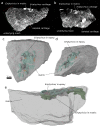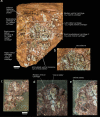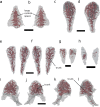The oldest three-dimensionally preserved vertebrate neurocranium
- PMID: 37730987
- PMCID: PMC10533405
- DOI: 10.1038/s41586-023-06538-y
The oldest three-dimensionally preserved vertebrate neurocranium
Abstract
The neurocranium is an integral part of the vertebrate head, itself a major evolutionary innovation1,2. However, its early history remains poorly understood, with great dissimilarity in form between the two living vertebrate groups: gnathostomes (jawed vertebrates) and cyclostomes (hagfishes and lampreys)2,3. The 100 Myr gap separating the Cambrian appearance of vertebrates4-6 from the earliest three-dimensionally preserved vertebrate neurocrania7 further obscures the origins of modern states. Here we use computed tomography to describe the cranial anatomy of an Ordovician stem-group gnathostome: Eriptychius americanus from the Harding Sandstone of Colorado, USA8. A fossilized head of Eriptychius preserves a symmetrical set of cartilages that we interpret as the preorbital neurocranium, enclosing the fronts of laterally placed orbits, terminally located mouth, olfactory bulbs and pineal organ. This suggests that, in the earliest gnathostomes, the neurocranium filled out the space between the dermal skeleton and brain, like in galeaspids, osteostracans and placoderms and unlike in cyclostomes2. However, these cartilages are not fused into a single neurocranial unit, suggesting that this is a derived gnathostome trait. Eriptychius fills a major temporal and phylogenetic gap in our understanding of the evolution of the gnathostome head, revealing a neurocranium with an anatomy unlike that of any previously described vertebrate.
© 2023. The Author(s).
Conflict of interest statement
The authors declare no competing interests.
Figures












Comment in
-
Getting inside the oldest known vertebrate skull.Nature. 2023 Sep;621(7980):696-698. doi: 10.1038/d41586-023-02865-2. Nature. 2023. PMID: 37730784 No abstract available.
References
-
- Gans, C. in The Skull Vol. 2 (eds. Hanken, J. & Hall, B. K.) 1–35 (Chicago Univ. Press, 1993).
-
- Janvier, P. Early Vertebrates (Clarendon, 1996).
-
- Janvier, P. in The Skull Vol. 2 (eds. Hanken, J. & Hall, B. K.) 131–188 (Chicago Univ. Press, 1993).
Publication types
MeSH terms
LinkOut - more resources
Full Text Sources
Miscellaneous

